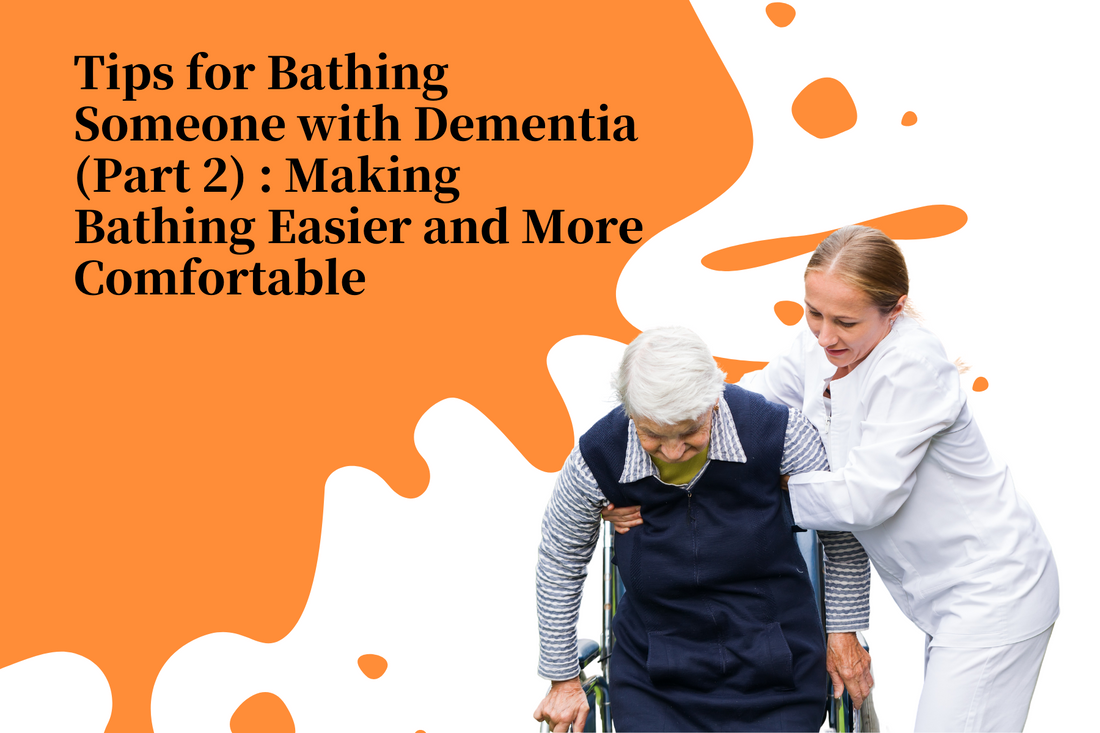Tips for Bathing Someone with Dementia (Part 2) : Making Bathing Easier and More Comfortable
13 Apr 2023
0 Comments
Continued from Part 1
2. Use simple phrases to guide the person through each step of the process, such as "Put your feet in the tub," "Sit down," "This is soap," and "Wash your arms."
3. Use non-verbal prompts, such as the "look at me" technique. Show your moves by placing your hand over the person's and gently guiding the washing action.
4. Use a bathtub bench or bath chair that can be adjusted to different heights to facilitate bathing.
5. Use a towel to block the water flowing to the face when washing hair. You can also use a shampoo artifact to prevent getting soap in the eyes.
6. Ensure hygiene and cleanliness of the genital area, especially for the elderly with urinary incontinence. Special washing is required between skin folds and under a woman's breasts.
Consider Bath Alternatives
1. Be open to adjusting bathing standards. Your bathing preferences may not match the needs or reality of the person you care for.
2. Wash a different part of the body each day of the week. Shampoo can be done at other times or on different days.
3. Wipe the patient's body with a towel between every two bath.
4. Clean the patient with a non-rinse soap product and a warm damp towel. Regular use of such products, which can be purchased at a pharmacy or drugstore, is also effective, according to the AARP research paper.
5. Find a professional nurse or nursing assistant to wash the patient at home.
After Bath Care
1. Check for rashes and ulcers, especially for the elderly who are incontinent or unable to walk.
2. Pat and absorb water with a towel instead of rubbing.
3. Dry between the toes with a cotton swab.
4. Apply prickly heat powder or cornstarch to the lower part of the breast and skin folds.
5. Apply lotion to keep the skin soft.
I hope the above content can help you better care for elderly patients with dementia.
Here is the article's link👉
1. Try to schedule the bath at the same time the patient is used to. If the person usually showers in the morning, an occasional evening bath may confuse the elderly.2. Use simple phrases to guide the person through each step of the process, such as "Put your feet in the tub," "Sit down," "This is soap," and "Wash your arms."
3. Use non-verbal prompts, such as the "look at me" technique. Show your moves by placing your hand over the person's and gently guiding the washing action.
4. Use a bathtub bench or bath chair that can be adjusted to different heights to facilitate bathing.
5. Use a towel to block the water flowing to the face when washing hair. You can also use a shampoo artifact to prevent getting soap in the eyes.
6. Ensure hygiene and cleanliness of the genital area, especially for the elderly with urinary incontinence. Special washing is required between skin folds and under a woman's breasts.
Consider Bath Alternatives
1. Be open to adjusting bathing standards. Your bathing preferences may not match the needs or reality of the person you care for.
2. Wash a different part of the body each day of the week. Shampoo can be done at other times or on different days.
3. Wipe the patient's body with a towel between every two bath.
4. Clean the patient with a non-rinse soap product and a warm damp towel. Regular use of such products, which can be purchased at a pharmacy or drugstore, is also effective, according to the AARP research paper.
5. Find a professional nurse or nursing assistant to wash the patient at home.
After Bath Care
1. Check for rashes and ulcers, especially for the elderly who are incontinent or unable to walk.
2. Pat and absorb water with a towel instead of rubbing.
3. Dry between the toes with a cotton swab.
4. Apply prickly heat powder or cornstarch to the lower part of the breast and skin folds.
5. Apply lotion to keep the skin soft.
I hope the above content can help you better care for elderly patients with dementia.
Tags:


